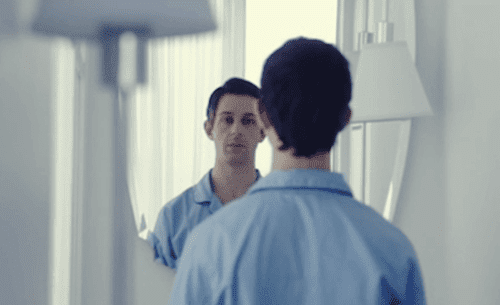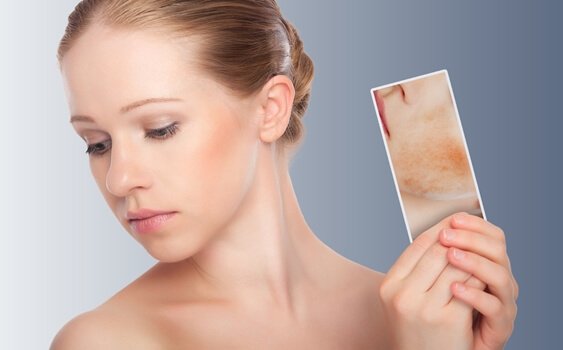Mirror Exposure Therapy: What Is it About?


Written and verified by the psychologist Valeria Sabater
Mirror exposure therapy is a psychological technique for the body and soul. It helps to treat negative body image, reduce anxiety, and untie the knots that intensify depression. In brief, this is a highly effective strategy to help you love and reconcile with the person in front of the mirror, that reflection that may scare you.
Many women and men despise what they see in the mirror. It makes them uncomfortable, tense, and even scared. Some people see fat in places where there is none. Others see wrinkles, ugliness, scars… a body full of flaws. It’s somewhat an unconscious process, where the mirror becomes an object of torture and the main defining factor of the individual’s self-esteem and identity.
These distortions often manifest themselves in pathologies such as eating disorders and dysmorphic disorders. Let’s explain a significant contrast. On one hand, a healthy person observes their body’s reflection with acceptance and pride. On the other hand, patients who suffer from these pathologies feel grossed out about their bodies as they see flaws that don’t even exist. This leads to extreme discomfort and suffering.
Several studies reveal that mirror exposure therapy can be quite helpful in cases where body dissatisfaction is so extreme that the patient ends up hating themselves. Additionally, it’s important to take into account that this therapy works best when the patient is also working on the management of their emotions and negative thoughts. It’s safe to say that these two processes go hand-in-hand. Let’s expand on this a little more.

What is mirror exposure therapy?
Mirror exposure therapy is highly effective. However, experts still don’t quite understand the mechanisms by which the patient finally comes to accept their own body image. Since no two cases are alike, the therapeutic tools that this technique uses vary according to each patient’s needs.
In 2016, Maastricht University studied the mechanisms that allowed bulimics or patients with low physical acceptance to improve in just over a month. An important observation was that working through the patients’ cognitive distortions and emotions played a big part in their recovery.
The Journal of Behavior Therapy and Experimental Psychiatry also published an interesting University of Granada study. The researchers scientifically demonstrated how female bulimic patients showed lower cortisol levels after mirror exposure therapy.
The three techniques of mirror exposure therapy
Two very specific techniques are usually used during this therapy:
- Guided exhibition: In this case, the trained psychologist encourages and guides the patient to describe their body while looking in the mirror. They must do it neutrally and objectively as if they were describing a canvas.
- Pure exhibition: The patient freely and authentically expresses everything they feel and experiences when they see their body. Of course, this technique is quite though as the patient evidently doesn’t like what they see. More often than not, they’ll describe themselves as ugly, hideous, and even deformed. However, this is very necessary for the therapeutic process.
Likewise, Griffen, TC, Naumann, E., and Hildebrandt, T. (2018) pointed out that these two techniques aren’t always effective in every single patient. In cases where neither work, mirror exposure therapy uses a third strategy, which tends to make things a lot easier:
- Mirror exposure with a positive approach: This tool helps reduce the person’s anguish (which is quite severe in almost every case). The therapist guides the patient to point out the areas of their body that they like the most. The main rule they have to follow is that they have to use positive language and can’t say negative things about their appearance. In case the person doesn’t see anything attractive in their body, the professional will be there to help and encourage them with phrases such as “I think you’re pretty”, “Your skin is very smooth”, or “Your hands are also very attractive”.

How does mirror exposure therapy work?
Many people wonder how it’s possible that patients show improvement after only six sessions. Patients are clearly less stressed, their self-esteem levels increase significantly, and they overall start appreciating their physical appearance a lot more. In fact, sooner or later they stop experiencing that body dysmorphia that haunted them. If a patient really shows improvement with mirror exposure therapy, it’s due to these reasons:
The four pillars of success of mirror exposure therapy
Modification of self-interpretation: A person with a dysmorphic or eating disorder associates any adverse situation of their daily life to their body image. If they make a mistake, someone rejects them, or someone lets them down, they automatically attribute it to their physique. This therapy helps eradicate those interpretations.
Attention bias: If the patient has a sharp nose, thick ankles, broad shoulders, little to no breasts, or excessive freckles, etc., they won’t focus on any other physical trait but those they consider flaws. With this clinical approach, this bias loses strength.
Reduction of fear and anxiety: With mirror exposure therapy, it’s possible to reduce the individual’s negative emotions by encouraging a positive relationship with the problematic stimulus: their physique.
Cognitive recycling: This strategy allows the patient to stop passing their image through a negative, rejection-provoking filter. This pillar allows the individual to regain respect and appreciation for themselves.
Undoubtedly, this technique can put an end to many people’s physical distortions. It can especially be a great tool for those who, without having yet developed an eating disorder, reject the image that the mirror reflects.
“People always ask me ‘You have so much confidence, where did that come from?’ It came from me. One day I decided that I was beautiful, and so I carried out my life as if I was a beautiful girl. It doesn’t have anything to do with how the world perceives you. What matters is what you see.”
-Gabourey Sidibe-
Mirror exposure therapy is a psychological technique for the body and soul. It helps to treat negative body image, reduce anxiety, and untie the knots that intensify depression. In brief, this is a highly effective strategy to help you love and reconcile with the person in front of the mirror, that reflection that may scare you.
Many women and men despise what they see in the mirror. It makes them uncomfortable, tense, and even scared. Some people see fat in places where there is none. Others see wrinkles, ugliness, scars… a body full of flaws. It’s somewhat an unconscious process, where the mirror becomes an object of torture and the main defining factor of the individual’s self-esteem and identity.
These distortions often manifest themselves in pathologies such as eating disorders and dysmorphic disorders. Let’s explain a significant contrast. On one hand, a healthy person observes their body’s reflection with acceptance and pride. On the other hand, patients who suffer from these pathologies feel grossed out about their bodies as they see flaws that don’t even exist. This leads to extreme discomfort and suffering.
Several studies reveal that mirror exposure therapy can be quite helpful in cases where body dissatisfaction is so extreme that the patient ends up hating themselves. Additionally, it’s important to take into account that this therapy works best when the patient is also working on the management of their emotions and negative thoughts. It’s safe to say that these two processes go hand-in-hand. Let’s expand on this a little more.

What is mirror exposure therapy?
Mirror exposure therapy is highly effective. However, experts still don’t quite understand the mechanisms by which the patient finally comes to accept their own body image. Since no two cases are alike, the therapeutic tools that this technique uses vary according to each patient’s needs.
In 2016, Maastricht University studied the mechanisms that allowed bulimics or patients with low physical acceptance to improve in just over a month. An important observation was that working through the patients’ cognitive distortions and emotions played a big part in their recovery.
The Journal of Behavior Therapy and Experimental Psychiatry also published an interesting University of Granada study. The researchers scientifically demonstrated how female bulimic patients showed lower cortisol levels after mirror exposure therapy.
The three techniques of mirror exposure therapy
Two very specific techniques are usually used during this therapy:
- Guided exhibition: In this case, the trained psychologist encourages and guides the patient to describe their body while looking in the mirror. They must do it neutrally and objectively as if they were describing a canvas.
- Pure exhibition: The patient freely and authentically expresses everything they feel and experiences when they see their body. Of course, this technique is quite though as the patient evidently doesn’t like what they see. More often than not, they’ll describe themselves as ugly, hideous, and even deformed. However, this is very necessary for the therapeutic process.
Likewise, Griffen, TC, Naumann, E., and Hildebrandt, T. (2018) pointed out that these two techniques aren’t always effective in every single patient. In cases where neither work, mirror exposure therapy uses a third strategy, which tends to make things a lot easier:
- Mirror exposure with a positive approach: This tool helps reduce the person’s anguish (which is quite severe in almost every case). The therapist guides the patient to point out the areas of their body that they like the most. The main rule they have to follow is that they have to use positive language and can’t say negative things about their appearance. In case the person doesn’t see anything attractive in their body, the professional will be there to help and encourage them with phrases such as “I think you’re pretty”, “Your skin is very smooth”, or “Your hands are also very attractive”.

How does mirror exposure therapy work?
Many people wonder how it’s possible that patients show improvement after only six sessions. Patients are clearly less stressed, their self-esteem levels increase significantly, and they overall start appreciating their physical appearance a lot more. In fact, sooner or later they stop experiencing that body dysmorphia that haunted them. If a patient really shows improvement with mirror exposure therapy, it’s due to these reasons:
The four pillars of success of mirror exposure therapy
Modification of self-interpretation: A person with a dysmorphic or eating disorder associates any adverse situation of their daily life to their body image. If they make a mistake, someone rejects them, or someone lets them down, they automatically attribute it to their physique. This therapy helps eradicate those interpretations.
Attention bias: If the patient has a sharp nose, thick ankles, broad shoulders, little to no breasts, or excessive freckles, etc., they won’t focus on any other physical trait but those they consider flaws. With this clinical approach, this bias loses strength.
Reduction of fear and anxiety: With mirror exposure therapy, it’s possible to reduce the individual’s negative emotions by encouraging a positive relationship with the problematic stimulus: their physique.
Cognitive recycling: This strategy allows the patient to stop passing their image through a negative, rejection-provoking filter. This pillar allows the individual to regain respect and appreciation for themselves.
Undoubtedly, this technique can put an end to many people’s physical distortions. It can especially be a great tool for those who, without having yet developed an eating disorder, reject the image that the mirror reflects.
“People always ask me ‘You have so much confidence, where did that come from?’ It came from me. One day I decided that I was beautiful, and so I carried out my life as if I was a beautiful girl. It doesn’t have anything to do with how the world perceives you. What matters is what you see.”
-Gabourey Sidibe-
All cited sources were thoroughly reviewed by our team to ensure their quality, reliability, currency, and validity. The bibliography of this article was considered reliable and of academic or scientific accuracy.
- Delinsky, SS, y Wilson, GT (2006). Exposición al espejo para el tratamiento de la alteración de la imagen corporal. Revista Internacional de Trastornos de la Alimentación , 39 (2), 108-116. https://doi.org/10.1002/eat.20207
- Jansen, A., Voorwinde, V., Hoebink, Y., Rekkers, M., Martijn, C., y Mulkens, S. (2016). Exposición al espejo para aumentar la satisfacción corporal. Revista de terapia conductual y psiquiatría experimental , 50 , 90-96. https://doi.org/10.1016/j.jbtep.2015.06.002
This text is provided for informational purposes only and does not replace consultation with a professional. If in doubt, consult your specialist.







